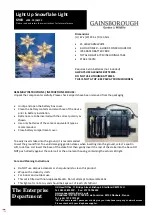
FTS 371 SMART USER MANUAL
Flash Technology, LLC
Revision 4 – 9/7/2021
15
CONTROLLER WIRING
For AC powered systems, see the controller wiring in Figure 6 (page) and typical installation diagrams in
(page 30) and
For DC powered systems, see the controller wiring in Figure 11 (page) and typical installation diagrams in
(page 35) and
INPUT POWER CONNECTI ONS
On the FTS 371 FTC SMART controller, the input
power will be connected to J1.
AC systems are not sensitive to input power phase
and have an operational voltage range of 85-265
VAC, 50/60 Hz with no modification necessary to
the input power module. The (2) 10A replaceable
input power fuses are located on F1 and F2. To
remove a fuse, disconnect power then push in and
turn counterclockwise.
On DC systems, observe polarity of input voltage
and connect positive to DC+ and negative to DC-.
There is one replaceable input power fuse located
at F1. To remove the fuse, disconnect power then
push in and turn counterclockwise.
BEACON AND MARKER CONNECTIONS
On the FTS 371 FTC SMART controller, the beacon connections are at J2 and marker connections are at J3.
For AC powered systems, up to two FTS 371 FH AC IR beacons may be connected. Connect the black wire to J2
terminal L1 and white wire to L2. Connect the green ground wire directly to the controller backplate using the
ground terminal installed near the Beacon PCB connector.
Note:
Some PCBs have a ground terminal (GND) on the
PCB J2 connector which is not used if the ground conductor is connected to the backplate.
FTS 371 FTC SMART AC
Beacon and Marker Connections
FTS 371 FTC SMART AC
Alternate Beacon Grounding Connection at J2
FTS 371 FTC SMART AC
Input Power Connections
FTS 371 FTC SMART DC
Input Power Connections
















































